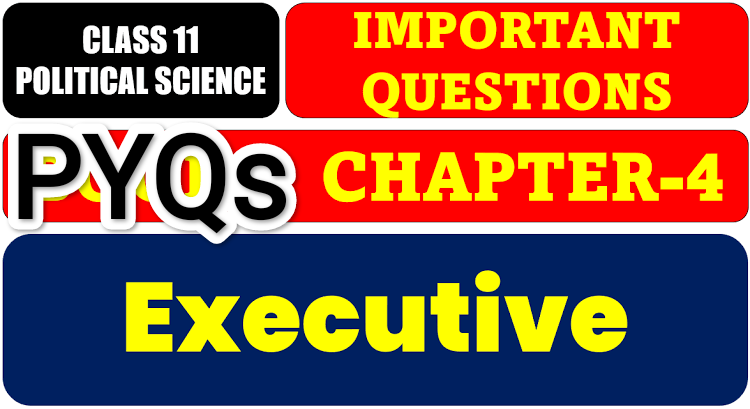Important 2-Mark & 6-Mark Questions (PYQs + NCERT based)
2 Mark Questions
Q1. Differentiate between political executive and permanent executive.
Answer:
० Political executive includes elected leaders (President, Prime Minister, Council of Ministers).
० Permanent executive consists of bureaucracy/civil servants who implement policies.
Q2. What is meant by ‘collective responsibility’ of the Council of Ministers?
Answer:
० All ministers are jointly responsible to the Lok Sabha.
० If Lok Sabha passes a no-confidence motion, the entire Council must resign.
Q3. Why is the President of India called the nominal head of the executive?
Answer:
० President exercises powers on the advice of the Council of Ministers.
० Real executive authority lies with the Prime Minister and Cabinet.
Q4. State one advantage of the permanent executive.
Answer:
० Provides continuity and stability in governance even when governments change.
Q5. Who appoints the Prime Minister and on what basis?
Answer:
० The President appoints the PM.
० The leader of the majority party (or coalition) in Lok Sabha is chosen.
Q6. What is meant by ‘individual responsibility’ of Ministers?
Answer:
० Each minister is accountable for decisions of his/her department.
० The Prime Minister can dismiss a minister for poor performance.
Q7. Why is bureaucracy also called the permanent executive?
Answer:
० Bureaucrats remain in office irrespective of political changes.
० They form the administrative backbone of the government.
Q8. State one difference between Parliamentary and Presidential form of executive.
Answer:
० Parliamentary: Executive responsible to legislature.
० Presidential: Executive independent of legislature.
Q9. Mention two discretionary powers of the President of India.
Answer:
० Can appoint Prime Minister when no party has a clear majority.
० Can dissolve Lok Sabha in case of political instability.
Q10. What is the meaning of a ‘cabinet form of government’?
Answer:
० Government where real powers rest with Cabinet headed by Prime Minister.
० Ministers are collectively responsible to legislature.
🔹 6-MARK QUESTIONS
Q1 . Explain the main differences between Parliamentary and Presidential systems of government.
Answer:
० Head of Executive:
Parliamentary: Dual executive (President = nominal, PM = real).
Presidential: Single executive (President = real head).
० Relationship with Legislature:
Parliamentary: Executive accountable to legislature.
Presidential: Executive independent of legislature.
० Tenure:
Parliamentary: Uncertain, depends on majority support.
Presidential: Fixed term of office.
० Decision-Making:
Parliamentary: Collective responsibility of Cabinet.
Presidential: Individual responsibility of President.
० Stability:
Parliamentary: May be unstable due to frequent political changes.
Presidential: More stable because of fixed tenure.
Q2. Describe the powers and functions of the Prime Minister of India.
Answer:
० Leader of the Council of Ministers: Chairs cabinet meetings, coordinates work.
० Advises the President: On appointments, dissolution of Lok Sabha, etc.
० Policy Making: Plays central role in formulation and implementation of policies.
० Parliamentary Role: Defends government in Lok Sabha, answers questions.
० Party Leadership: Provides leadership to ruling and coalition partners.
० Crisis Management: Takes decisions during emergencies and wars.
० International Role: Represents India in international forums and foreign relations.
Q3. What are the powers of the President of India?
Answer:
० Executive Powers: Appoints PM, Ministers, Governors, judges, ambassadors.
० Legislative Powers: Summons, prorogues Parliament; gives assent to bills.
० Financial Powers: Ensures money bills introduced only with prior recommendation.
० Judicial Powers: Can grant pardons, reprieves, commutations.
० Emergency Powers: Can declare National, State, and Financial Emergency.
० Discretionary Powers: Appointing PM in hung Parliament, dissolving Lok Sabha.
Q4. Explain the role of bureaucracy in India.
Answer:
० Implementation: Executes policies and laws passed by legislature.
० Continuity: Provides stability irrespective of political changes.
० Expertise: Offers professional advice to ministers.
० Administration: Manages day-to-day governance, law and order, welfare schemes.
० Neutrality: Works impartially under political leadership.
० National Integration: All India Services help maintain unity and uniformity.
Q5. How is the Council of Ministers collectively responsible to the Lok Sabha?
Answer:
० No-Confidence Motion: If passed, entire Council must resign.
० Collective Decisions: All ministers defend cabinet policies, even if disagreed privately.
० Accountability: Ministers answer to Lok Sabha for government functioning.
० Resignation Rule: Failure of one minister may lead to resignation of entire Council.
० Democratic Control: Ensures executive remains accountable to people’s representatives.
Q6. Discuss the discretionary powers of the President of India.
Answer:
० Hung Parliament: Choosing PM when no party has majority.
० Dissolution: Can dissolve Lok Sabha when government loses majority.
० No Confidence: Can act when ministry resigns and no alternative exists.
० Emergency Situations: Has special powers under Articles 352, 356, 360.
० Refusal of Assent: Can return a bill once for reconsideration.
० Significance: Ensures constitutional stability during political uncertainty.







